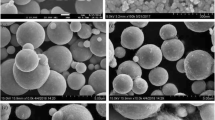Abstract
The finishing action in magnetorheological abrasive flow finishing (MRAFF) process relies mainly on bonding strength around abrasive particles in magnetorheological polishing (MRP) fluid due to cross-linked columnar structure of carbonyl iron particles. The fluid flow behaviour of MRP fluid exhibits a transition from weak Bingham liquid-like structure to a strong gel-like structure on the application of magnetic field. Depending on the size and volume concentration of abrasives and carbonyl iron particles (CIPs) in the base medium, the rheological properties hence, bonding strength gained by abrasives through surrounding CIP chains varies. To study the effect of particle size on rheological properties of MRP fluid, a hydraulically driven specially designed capillary magnetorheometer was fabricated. The rheological properties of MRP fluids in the homogeneous magnetic field perpendicular to the shear flow direction are evaluated. The three constitutive models, viz. Bingham plastic, Herschel–Bulkley and Casson’s fluid, are used to characterise the rheological behaviour of MRP fluid by fitting the rheological data obtained from capillary magnetorheometer and evaluating respective constants in their constitutive equations.
Similar content being viewed by others
References
Jha Sunil, Jain VK (2004) Design and development of magnetorheological abrasive flow finishing (MRAFF) process. Int J Mach Tools Manuf 44(10):1019–1029 doi:10.1016/j.ijmachtools.2004.03.007
Rabinow J (1948) The magnetic fluid clutch. AIEE Trans 67:1308
Jha S, Jain VK, Komanduri R (2006) Effect of extrusion pressure and number of finishing cycles on surface roughness in magnetorheological abrasive flow finishing (MRAFF) process. Int J Adv Manuf Technol 33:725–729
Phule PP (1998) Synthesis of novel magnetorheological fluids. MRS Bull 23:23–25
Rankin PJ, Horvath AT, Klingeberg DJ (1999) Magnetorheology in viscoplastic media. Rheol Acta 38:471–477 doi:10.1007/s003970050198
Jolly MR, Bender JW, Carlson JD (2000) Properties and applications of commercial magnetorheological fluids. J Intell Mater Syst Struct 10(1):5–13 doi:10.1106/R9AJ-XYT5-FG0J-23G1
Phule PP, Ginder JM (1999) Synthesis and properties of novel magnetorheological fluids having improved stability and redispersibility. Int J Mod Phys B 13/14–16:2019–2027
Genc S, Phule PP (2002) Rheological properties of magnetorheological fluids. Smart Mater Struct 11:140–146 doi:10.1088/0964-1726/11/1/316
Jolly MR, Carlson JD, Munoz BC (1996) A model of the behaviour of magnetorheological materials. Smart Mater Struct 5:607–614 doi:10.1088/0964-1726/5/5/009
Macosko CW (1994) Rheology: principles, measurements, and applications. VCH, New York
Ginder JM, Davis LC (1994) Shear stresses in magnetorheological fluids: role of magnetic saturation. Appl Phys Lett 65:3410–3412 doi:10.1063/1.112408
Carlson JD, Catanzarite DM, Clair KA (1996) Commercial magnetorheological fluid devices. Int J Mod Phys B 10:2857–2865 doi:10.1142/S0217979296001306
Ginder JM (1998) Behaviour of magnetorheological fluids. MRS Bull 23:26–29 (Aug)
Rosenfeld N, Wereley NM, Radakrishnan R, Sudarshan TS (2002) Behavior of magnetorheological fluids utilizing nanopowder iron. Int J Mod Phys B 16/17–18:2392–2398
Casson N (1959) In: Mill CC (ed) Rheology of dispersed systems, vol. 84. Pergamon, Oxford
Dash RK, Mehta KN, Jayaraman G (1996) Casson fluid flow in a pipe filled with a homogeneous porous medium. Int J Eng Sci 34(10):1145–1156 doi:10.1016/0020-7225(96)00012-2
Fung YC (1981) Mechanical properties of living tissues, Chapter 3. Biomechanics Springer, New York
Jdayil BA, Asoud H, Brunn PO (2007) Effect of polymer coating on the behavior of an electro-rheological fluid in slit flow. Mater Des 28:928–940
Macosko CW (1994) Rheology: principles, measurements, and applications. VCH, New York
Lemaire E, Bossis G (1991) Yield stress and wall effects in magnetic colloidal suspensions. J Phys D 24:1473–1477 doi:10.1088/0022-3727/24/8/037
Laun HM, Kormann C, Willenbacher N (1996) Rheometry of magnetorheological (MR) fluids—I. Steady shear flow in stationary magnetic fields. Rheol Acta 35:417–432 doi:10.1007/BF00368993
Shorey AB, Kordonski WI, Gorodkin SR, Jacobs SD, Gans RF, Kwong KM et al (1999) Design and testing of a new magnetorheometer. Rev Sci Instrum 70(11):4200–4206 doi:10.1063/1.1150052
Odenbach S, Stork H (1998) Shear dependence of field induced contributions to the viscosity of magnetic fluids at low shear rate. J Magn Magn Mater 183:188–194 doi:10.1016/S0304-8853(97)01051-2
Dang A, Ooi L, Fales J, Stroeve P (2000) Yield stress measurements of magnetorheological fluids in tubes. Ind Eng Chem Res 39:2269–2274 doi:10.1021/ie9908276
Chin BD, Park JH, Kwon MH, Park OO (2001) Rheological properties and dispersion stability of magnetorheological (MR) suspensions. Rheol Acta 40:211–219 doi:10.1007/s003970000150
Van Wazer JR, Lyons JW, Kim KY, Colwell RE (1963) Viscosity and flow measurement. Wiley, New York
Chhabra RP, Richardson JF (1999) Non-newtonian flow in the process industries—fundamentals and engineering applications. Butterworth Heinemann, Oxford
Jha Sunil, Jain VK (2006) Modeling and simulation of surface roughness in magnetorheological abrasive flow finishing (MRAFF). Process Wear 261(7–8):856–866 doi:10.1016/j.wear.2006.01.043
Author information
Authors and Affiliations
Corresponding author
Rights and permissions
About this article
Cite this article
Jha, S., Jain, V.K. Rheological characterization of magnetorheological polishing fluid for MRAFF. Int J Adv Manuf Technol 42, 656–668 (2009). https://doi.org/10.1007/s00170-008-1637-8
Received:
Accepted:
Published:
Issue Date:
DOI: https://doi.org/10.1007/s00170-008-1637-8




